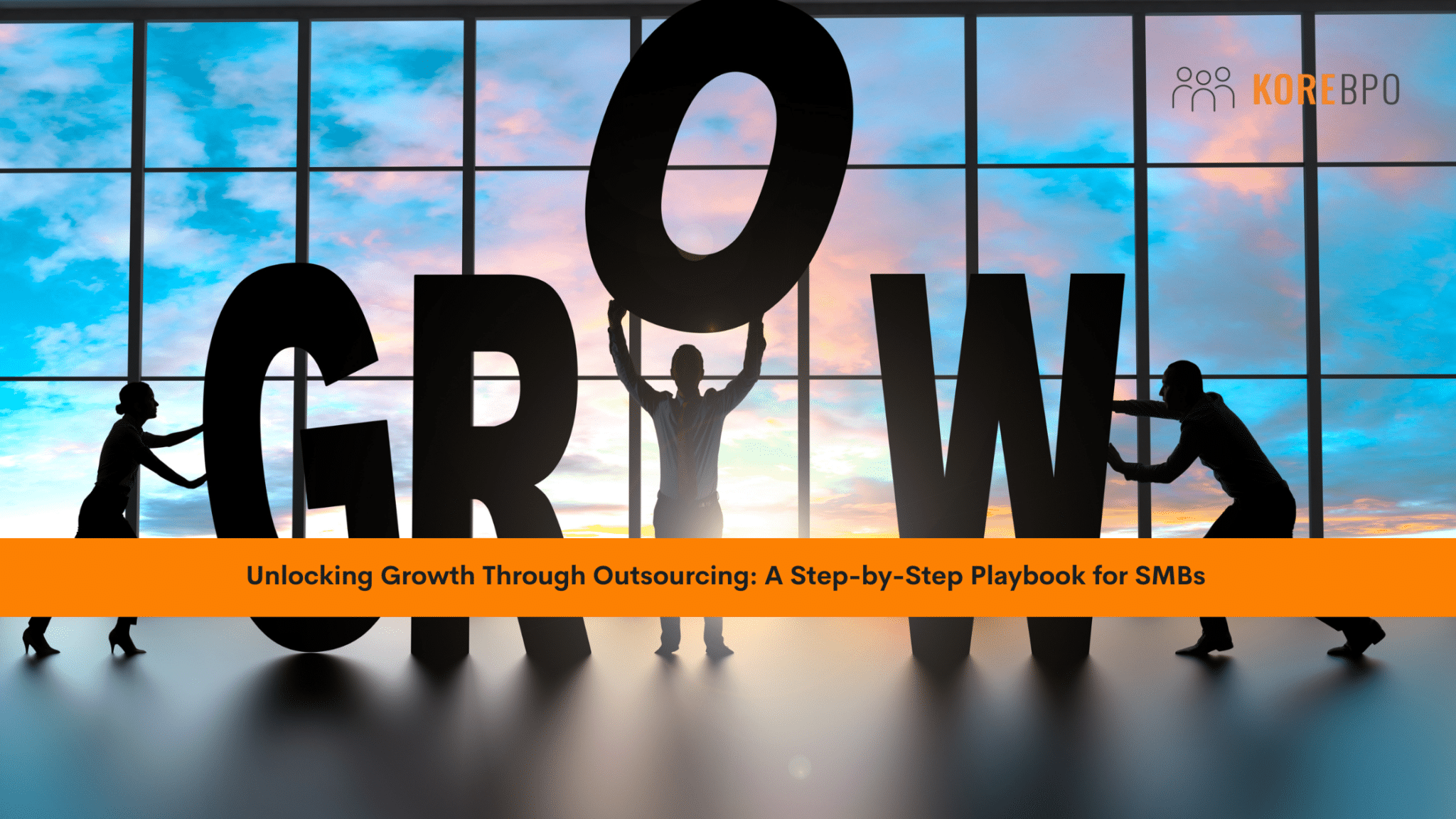Are You Working Harder Than You Should Be?
If you’re running a business, let me guess.
You’re wearing too many hats. CEO, sales, operations, IT, marketing.
You spend hours on admin tasks that don’t actually grow your business.
You know you need help, but hiring full-time employees is too expensive.
I’ve been there.
That’s why I’m going to show you exactly how to outsource the right way without sacrificing quality, control, or customer experience.
Here’s what we’ll cover.
- What to outsource and what to keep in-house
- How to find reliable outsourcing partners
- The biggest outsourcing mistakes and how to avoid them
- How to manage an outsourced team like a pro
Most importantly, I’ll show you how outsourcing can actually improve your bottom line. Let’s dive in.
Why Smart Business Owners Are Outsourcing (And Why You Should, Too)
Let’s talk numbers.
Seventy percent of businesses outsource to cut costs (ScaleUp Ally), but saving money isn’t the only reason.
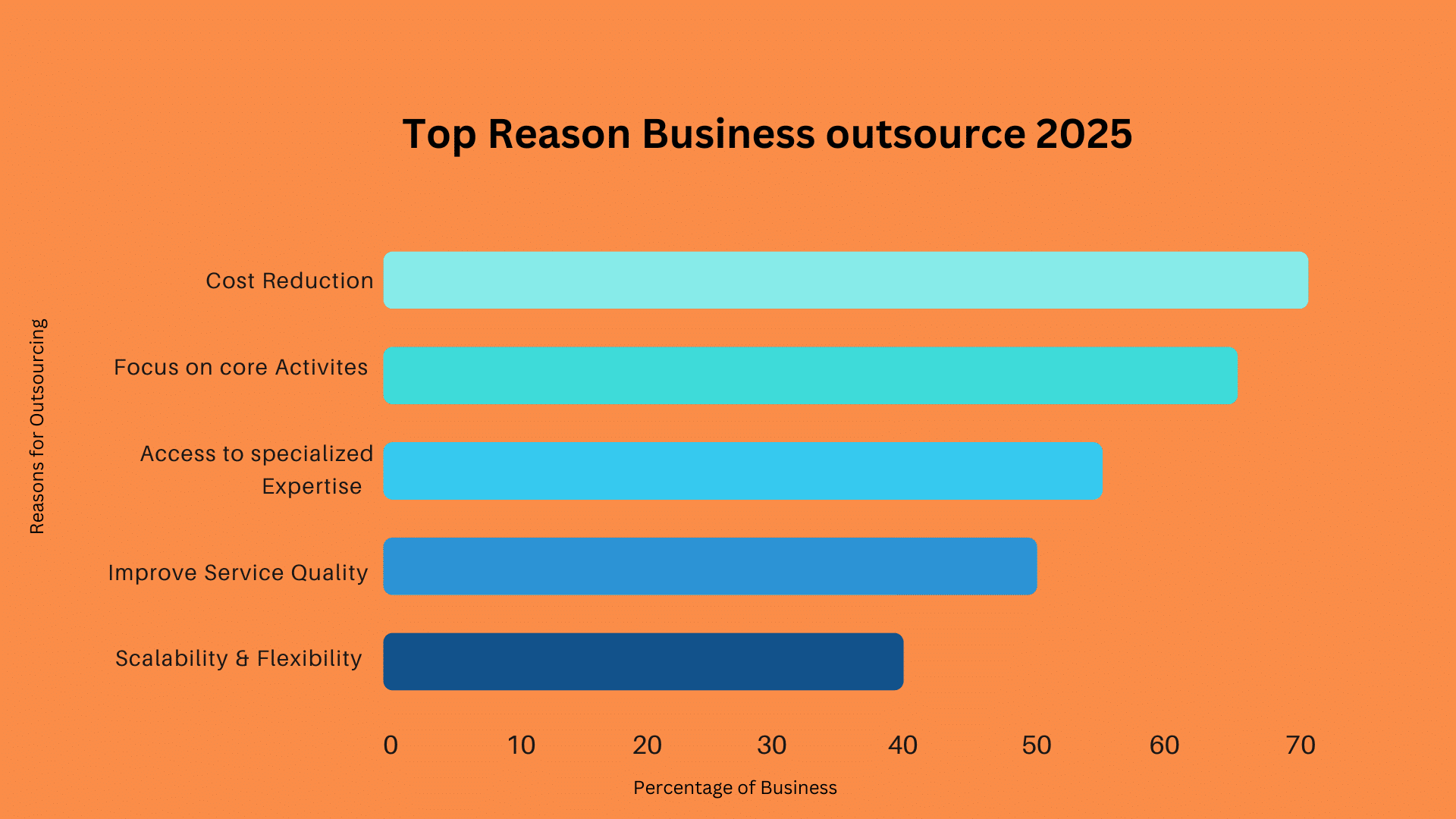
Three Big Benefits of Outsourcing for SMBs
1 Lower Costs Without Sacrificing Quality
Hiring in-house means paying for salaries, benefits, office space, and equipment.
Outsourcing lets you pay only for the work you need, when you need it.
2 Access to Top Talent Without Expensive Recruiting
Need an SEO expert or an appointment setter? No need to hire full-time.
With outsourcing, you get pre-vetted professionals ready to hit the ground running.
3 More Time to Focus on Growth
If your day is packed with admin work, customer support, or invoicing, you’re not growing your business.
Outsourcing frees you up to focus on strategy, sales, and scaling.
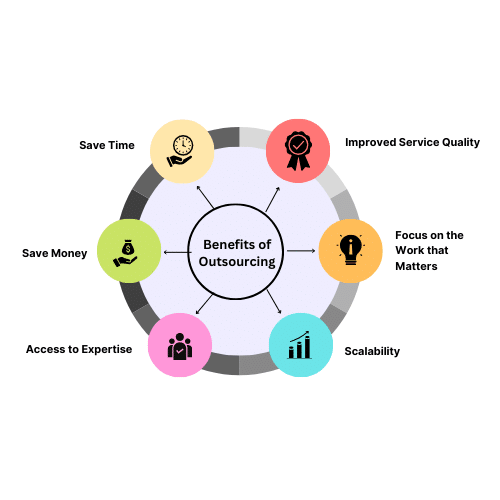
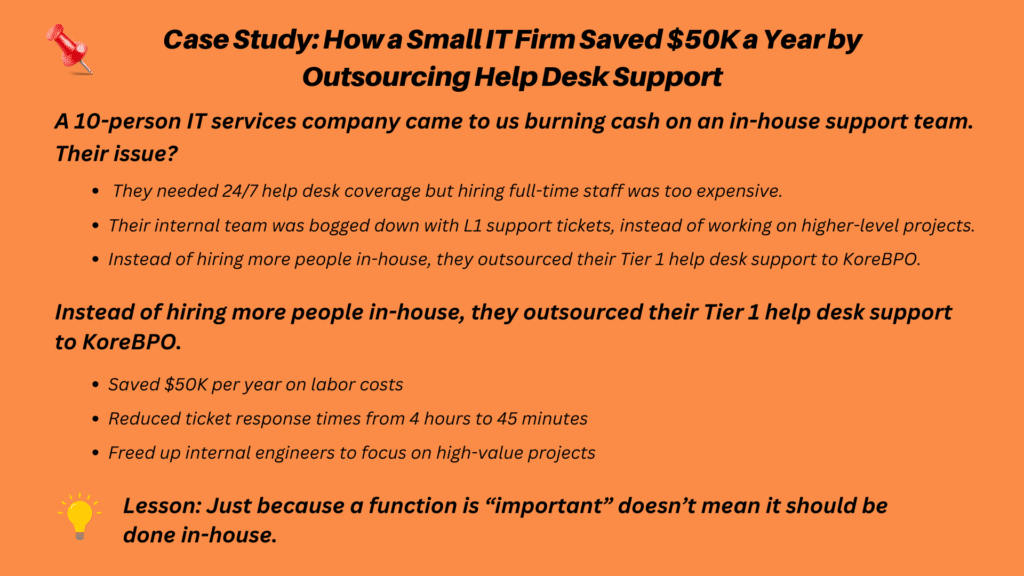
What Should You Outsource? (Time & Value Assessment)
Not everything should be outsourced, but that doesn’t mean you should do everything yourself.
The key is knowing what drains your time versus what actually moves your business forward.
How to Decide What to Outsource
Track your tasks for a full week. Write down everything you do.
Sort them into two categories:
- High-Value Tasks – Revenue-generating and strategy-driven. Keep these in-house.
- Low-Value, Time-Draining Tasks – Repetitive, admin-heavy, or time-consuming. These should be the first to go.
Best Tasks to Outsource
Admin Work – Emails, scheduling, CRM updates
Marketing – Social media, content creation, PPC
Sales Support – Prospecting, appointment setting
Customer Service – Handling inquiries, live chat, support tickets
Bookkeeping & Finance – Payroll, invoicing, financial reporting
Data Entry & Research – Market analysis, competitor tracking
What Should Stay In-House?
- Business strategy & leadership
- Building and maintaining client relationships
Pro Tip: If a task is repetitive, manual, and not directly driving revenue, outsource it.
If someone can do it 70-80% as well as you, delegate it.
The Delegation Problem That Holds Business Owners Back
Most business owners struggle with delegation.
And I get it. I used to as well. Trusting someone else with something you built isn’t easy.
But here’s the reality.
If you refuse to let go of admin work, sales support, or customer service, you’re not “saving money.”
You’re bottlenecking your growth.
Here’s the rule I give my clients:
If a task doesn’t generate revenue or require your expertise, it shouldn’t be on your plate.
That’s how you scale without working 80-hour weeks.
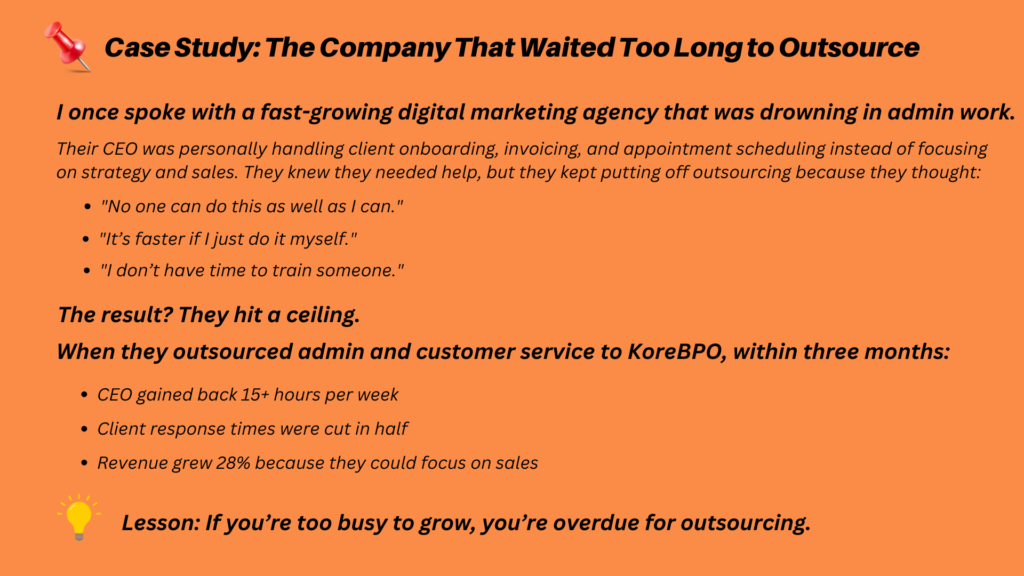
How to Choose the Right Outsourcing Partner (Without Getting Burned)
I’ve seen businesses lose thousands of dollars by choosing the wrong outsourcing provider.
Cheap labor. Poor communication. Missed deadlines.
A bad outsourcing decision doesn’t just waste money it slows down your entire business.
Here’s how to get it right from the start.
Five Must-Haves in an Outsourcing Partner
Industry Expertise – Do they understand your business? A generalist won’t cut it.
Proven Track Record – Ask for case studies and references to see if they’ve successfully worked with companies like yours.
Strong Communication – If they take days to respond, run. Fast communication keeps projects on track.
Scalability – Can they grow with you, or will you have to start over when your business expands?
Security & Compliance – If you handle financial, legal, or healthcare data, compliance matters. Choose a provider that meets GDPR, HIPAA, or ISO standards.
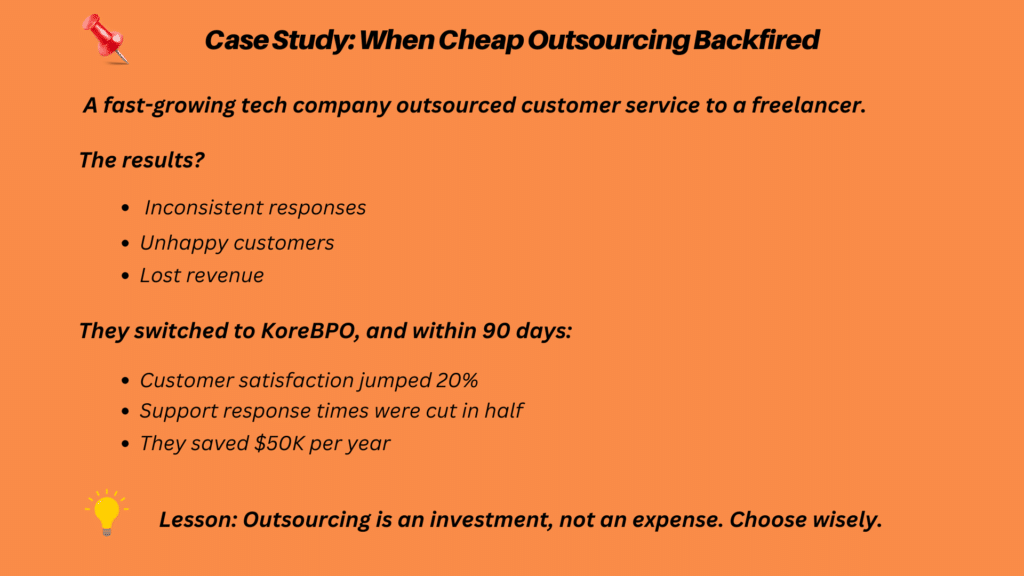
The Biggest Outsourcing Mistakes I See
Most businesses think outsourcing = cost-cutting.
Sure, saving money is a bonus. But the real reason to outsource is to buy back your time and focus on growth.
Here’s where most business owners go wrong:
They go cheap. They hire the lowest-cost freelancer they can find, then wonder why they get missed deadlines, bad communication, and low-quality work.
They don’t set expectations. Without clear guidelines, they spend more time fixing mistakes than outsourcing actually saves them.
How to Do It Right: Treat Outsourcing Like Hiring an Employee
- Set clear KPIs. Define what success looks like before you delegate a single task.
- Provide proper onboarding. Even outsourced teams need training and process documentation.
- Communicate regularly (without micromanaging). Use tools like Slack, Asana, or Trello to track progress without being overbearing.
Outsourcing isn’t a quick fix but when done right, it’s the most powerful way to scale.
| Factor | Good Outsourcing Provider | Bad Outsourcing Provider |
|---|---|---|
| Industry Expertise | Specializes in your industry, understands specific challenges. | Generic services, no proven experience in your niche. |
| Proven Track Record | Case studies, client testimonials, and successful past projects. | No track record, vague claims, or no references. |
| Communication & Responsiveness | Fast response times, proactive updates, and clear project timelines. | Slow responses, missed deadlines, and unclear communication. |
| Transparency & Pricing | Clear, upfront pricing with detailed service breakdowns. | Hidden fees, unclear costs, or unrealistic low pricing. |
| Quality Control | Structured training, quality checks, and dedicated account managers. | No monitoring, inconsistent quality, and lack of accountability. |
| Scalability & Flexibility | Can scale with your business and adjust resources as needed. | Rigid contracts, unable to adapt to changing needs. |
| Data Security & Compliance | Adheres to GDPR, HIPAA, or ISO standards for secure data handling. | No clear policies on data security or compliance. |
| Hiring & Training Process | Vetted, well-trained staff with specialized skills. | Random freelancers with no formal training. |
| Performance Metrics & KPIs | Regular reporting, clear KPIs, and continuous improvement. | No performance tracking, no clear deliverables. |
| Customer Support & Problem Resolution | Dedicated support team, quick issue resolution, and ongoing assistance. | No support structure, difficult to reach, and slow to fix issues. |
Where to Find the Best Outsourcing Talent
Most businesses go straight to freelance marketplaces when they think about outsourcing.
It seems easy. Post a job. Pick the lowest bidder. Get started.
But here’s the problem.
Freelancers can be hit or miss. Some disappear mid-project. Others need constant hand-holding.There’s a big difference between hiring a freelancer and partnering with a BPO (Business Process Outsourcing) provider.
Why Choose a BPO Over Freelance Marketplaces?
Vetted & Pre-Trained Talent – No need to waste time testing and filtering candidates.
Consistent Support & Management – A BPO ensures ongoing training, tracking, and accountability.
Scalability – Need more support as you grow? A BPO can easily scale with you.
Reduced Risk – No ghosting, high turnover, or quality issues that come with freelancers.
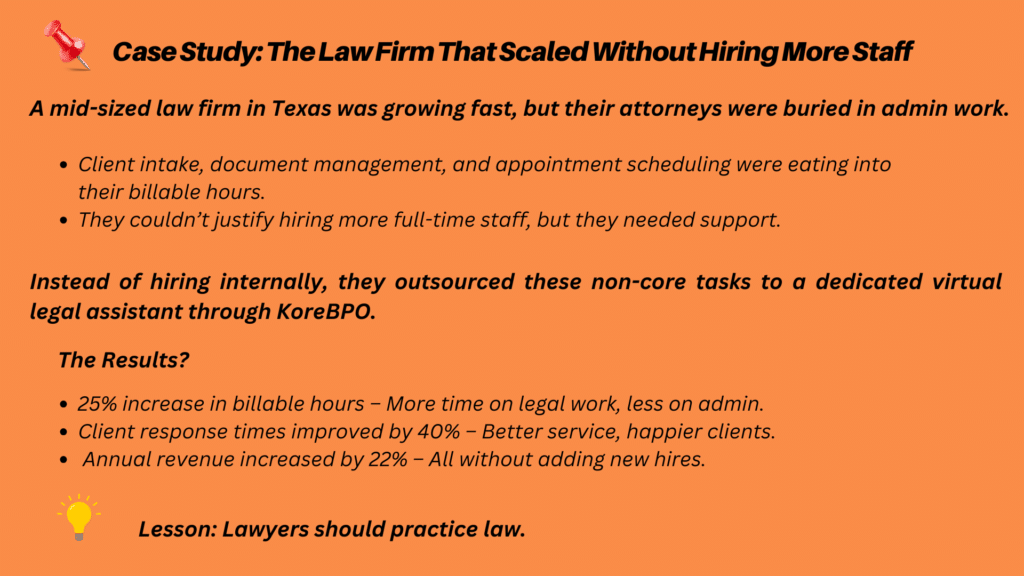
If you’re spending time on low-value work, you’re losing money.
How to Manage an Outsourced Team Like a Pro
Most businesses make the same mistake when outsourcing. They hire someone and hope for the best.
That never works.
Outsourcing isn’t a “set it and forget it” strategy. You need a process to make it work.
If you want outsourcing to save you time instead of creating more problems, follow this simple process.
Three Steps to Managing an Outsourced Team Effectively
Step 1: Do the Task Yourself First – You can’t delegate what you don’t understand. Knowing the process helps you set clear expectations.
Step 2: Optimize & Document – Can it be automated? Can you create a checklist? The smoother the process, the better the results.
Step 3: Record a Step-by-Step Guide – Use Loom videos, Google Docs, or Trello so your team has a clear reference point.
Why This Matters
A structured process eliminates miscommunication, constant back-and-forth, and inconsistent results.
Pro Tip:
If you find yourself repeatedly explaining the same tasks, you don’t have a people problem. You have a documentation problem.
Best Practices for Managing an Outsourced Team
Daily Communication – Use Slack, WhatsApp, or Microsoft Teams to stay connected.
Weekly Check-Ins – Hold short 15-minute meetings to review updates and provide feedback.
Clear SOPs & Documentation – Standardize tasks using Loom videos and Notion.
Use the Right Project Management Tools – Track progress with Trello, Click Up, or Asana.
What the Best Teams Have in Common
The best teams whether in-house or outsourced run on clear communication and accountability.
If you don’t have a system for tracking work, that’s where you need to start.
Biggest Mistake? Micromanaging.
If you’re constantly checking in, rewriting their work, or answering the same questions over and over, you haven’t really outsourced.
Trust the process. That’s how you get the most out of your outsourced team.
How to Hire the Right People
The biggest mistake business owners make when outsourcing? Choosing a provider based on price instead of fit.
You can train someone on a skill, but you can’t teach work ethic, accountability, or attention to detail.
If you want a team that actually helps your business grow, focus on hiring the right kind of people not just the cheapest option.
What to Look for in an Outsourced Hire
Detail-Oriented – Follows instructions carefully and doesn’t cut corners.
Proactive – Asks questions, suggests improvements, and looks for ways to add value.
Reliable – Meets deadlines, takes ownership of tasks, and works independently.
Good Communicator – Responds quickly, gives clear updates, and isn’t afraid to ask for clarification.
Pro Tip:
A bad hire will cost you more in time, frustration, and mistakes than investing in the right person from the start.
Choose wisely, and outsourcing becomes a scalable advantage not another headache.
Set Clear Goals & Success Metrics
Most outsourcing frustrations aren’t caused by bad hires they come from unclear expectations.
If you don’t define what success looks like, your outsourced team won’t know how to deliver.
Before you delegate, make sure you set clear goals from the start.
How to Set Goals That Actually Work
Define Expected Outcomes – Be specific. Instead of saying “help with lead generation,” say “Generate 30 qualified leads per week.”
Set Quality Benchmarks – If customer support is outsourced, your goal might be “Maintain a 90%+ customer satisfaction rating.”
Establish Deadlines – Every task should have clear due dates so expectations are set from day one.
Mindset Shift:
Stop micromanaging.
Your job is to define what needs to be done, not obsess over how it gets done.
When you trust your outsourced team and focus on results instead of control, you get better outcomes with less stress.
Scaling Your Outsourced Team
Once you’ve successfully outsourced a few tasks, it’s time to scale.
The key is building a system that allows you to expand without adding unnecessary complexity.
How to Scale Outsourcing the Right Way
Develop a Repeatable Hiring Process – Keep a list of pre-vetted candidates so you’re ready to bring on new team members as needed.
Create an Onboarding Checklist – Standard operating procedures (SOPs) and training videos make it easy to get new hires up to speed.
Let Go of Micromanaging – If you’re still buried in the details, you haven’t really outsourced.
Empower Your Team – Give them ownership of tasks and decision-making so you can focus on strategy.
Real-World Example: From Admin Tasks to Full Operations Support
One of our clients started by outsourcing only admin work.
Within a year, they had expanded outsourcing to customer service, lead generation, and finance support all while keeping fixed costs low.
The best part? Their internal team stayed lean, efficient, and focused on high-value work.
When you outsource strategically, you grow smarter not just bigger.
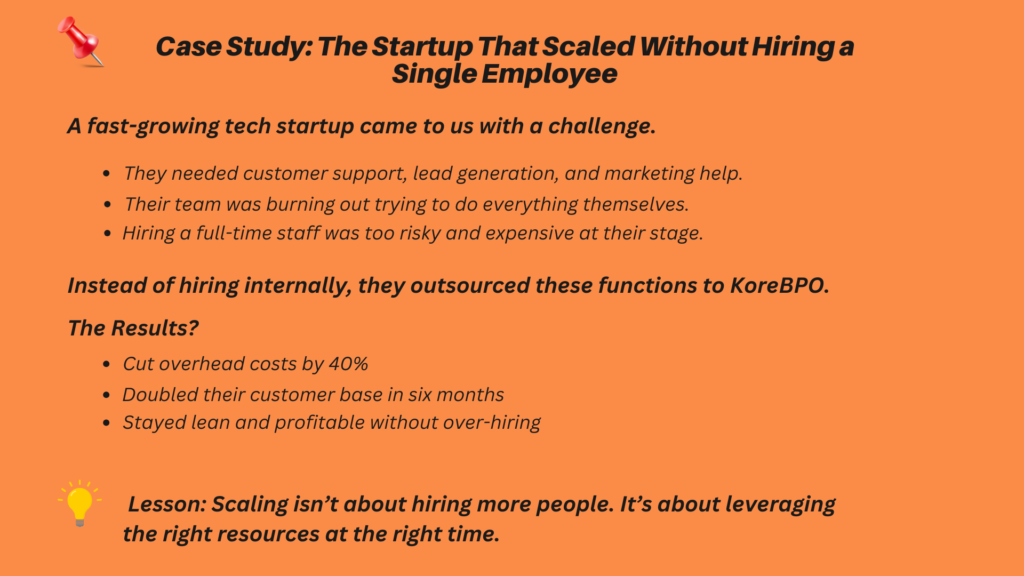
Avoid These Costly Outsourcing Mistakes
- Hiring the cheapest provider (You get what you pay for.)
- No clear KPIs (How will you measure success?)
- No onboarding process (Training matters even for outsourced teams.)
- Micromanaging instead of trusting your team
The Future of Outsourcing: What’s Next?
The way businesses outsource is evolving, and those who adapt will stay ahead. Here’s where outsourcing is headed:
AI & Automation – AI-powered outsourcing is on the rise, but human oversight is still essential for quality and decision-making.
On-Demand Outsourcing – More businesses are shifting to fractional teams instead of hiring full-time employees, keeping operations flexible and cost-effective.
Hybrid Models – The smartest companies are blending in-house teams with outsourced support to create the most efficient workforce.
Brian’s Prediction:
“SMBs that combine AI and outsourcing will have a massive competitive edge over the next five years. The businesses that leverage both will scale faster, stay leaner, and operate more efficiently.”
This isn’t just about cutting costs. It’s about building a smarter, more agile business. Are you ready?
Final Thoughts: Should You Outsource? (Use This Free ROI Calculator)
Outsourcing isn’t about replacing your team. It’s about focusing your time on what truly moves the needle.
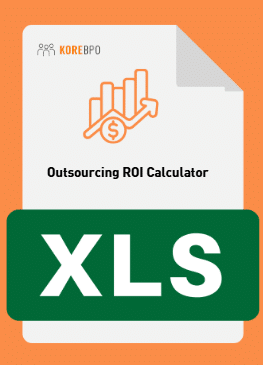
Want to see where you could save?
Download Our Free ROI Calculator Here!
Stop wasting time on tasks that don’t grow your business. Start outsourcing smarter today.
Our Outsourcing Checklist
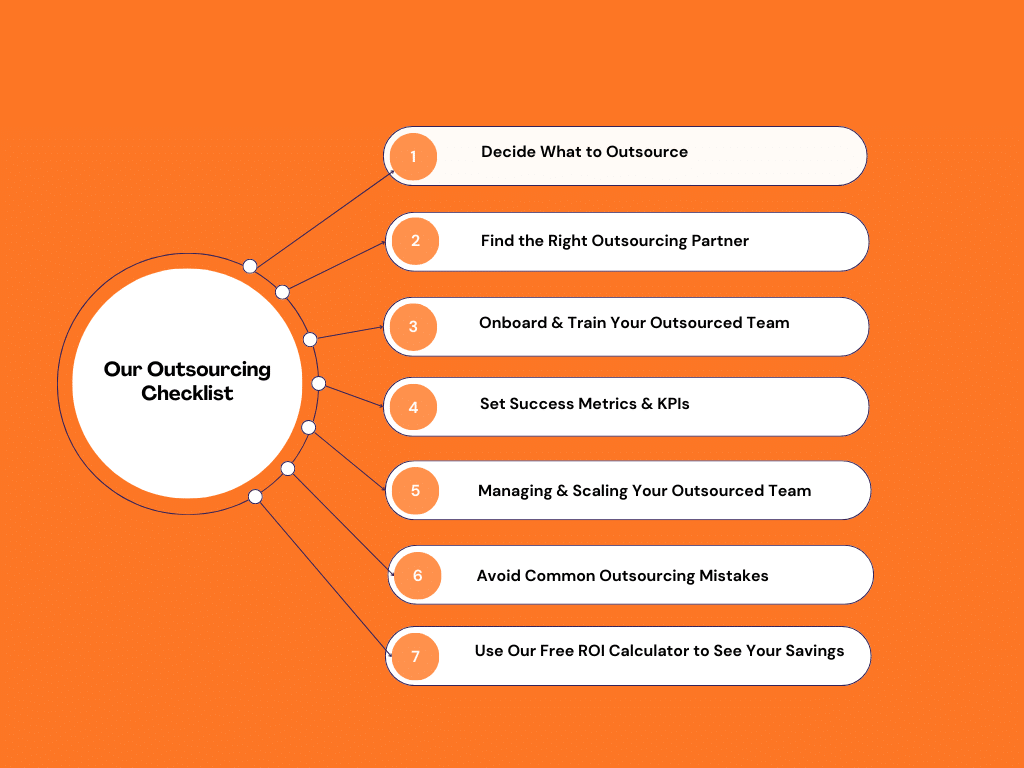
We’ve put together “The Ultimate Outsourcing Checklist” to help businesses like yours avoid common pitfalls and make smarter decisions when partnering with an outsourcing provider.
If you’re here, you’re already thinking about optimizing your processes this outsourcing checklist will guide you through everything from vendor selection to performance tracking.


